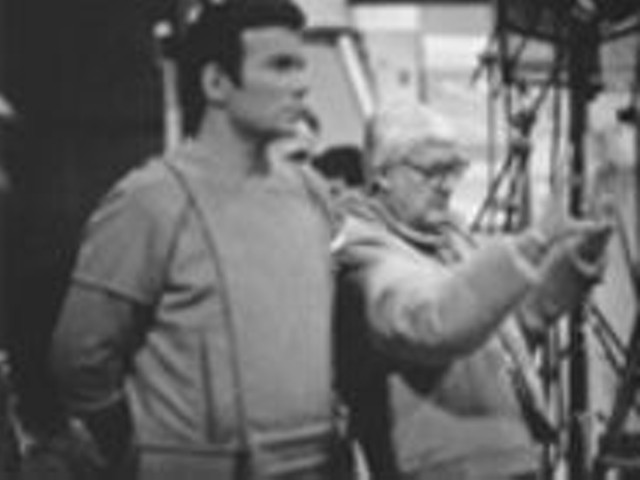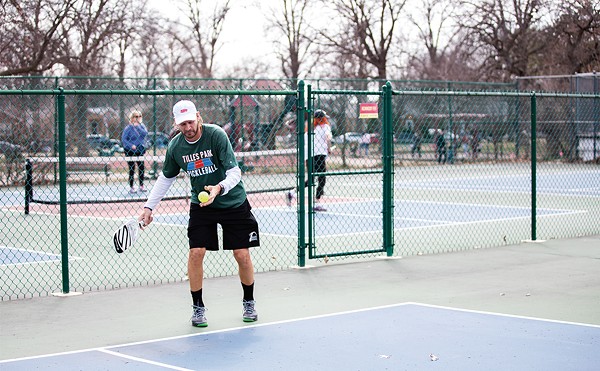In Ronald Harwood's intriguing but talky Taking Sides, the moral compass spins like a weathervane in a gale. Was Furtwängler Hitler's tool or an indifferent bystander? Did he refuse to salute der Fhrer, or did he pander to his every whim? And what about Maj. Arnold, an unapologetic philistine who claims, more than once, that he is "totally uncultured"? What gives him the right to assess the activities of a world-renowned conductor, especially one whose activities weren't quite as blatant as those of, say, Leni Riefenstahl? (Titles of Furtwängler biographies express alpha and omega views on the maestro, from The Devil's Music Master to Trial of Strength.)
At the Jewish Community Center, director Tom Murray has assembled a production that plays up all the claustrophobia of a prolonged interrogation. Unfortunately, too frequently Taking Sides veers into stock melodrama. This seems to be a problem inherent in the script, which is never content to make a claim and develop a point of view without constantly referring to the original claim -- good jurisprudence but occasionally numbing theater, especially in the very long second act. Even there, however, details about Herbert von Karajan's conducting philosophy vs. Furtwängler's -- "discipline vs. inspiration" -- are fascinating and make one want to listen to competing recordings (snippets are played in the play).
As Maj. Arnold, David S. Brink is the slangy can-do American, although his affect seems too calculated early on. Dramatic tension could have built more effectively if Harwood hadn't made his character announce at the beginning, "I've seen things with these eyes," a line Olivier might have choked on. Arnold is basically one man against a parade of petitioners, but he meets his match with Furtwängler. Played by a taut yet weary Garrett Bergfeld, Furtwängler literally towers over his adversary (and therefore plays most of his scenes sitting down). Bergfeld strikes the right note of arrogance, especially when Furtwängler's real secrets, which mostly have to do with the vanity and callousness of genius, emerge. John A. Dalton plays Lt. David Wills, who's supposed to assist Maj. Arnold but ends up playing devil's advocate. He's Jewish but is more than willing to forgive Furtwängler's alleged transgressions because "he is like any other great artist." The scenes between Wills and Arnold could have benefited from sharper timing and fewer smoldering looks of disagreement, and the audience could have benefited from not knowing Wills' perspective so soon.
Special praise goes to Lavonne Byers and Bob Koerner as the bedraggled Tamara and Helmuth. Byers puts real delicacy and nuance in a stock part -- a woman over the verge of hysteria. When the Americans serve her coffee with cream and sugar, Byers' eyes light up and her shoulders straighten. This small epiphany makes the audience suddenly wonder how many years it has been since this sad soul even smelled real coffee. Koerner's Helmuth is simply a jewel: apologizing, ingratiating and, in the end, collaborating -- with the Americans. Fine work also comes from young Melissa Hogan, who plays Maj. Adams' German stenographer with appropriate cringing and wincing. Chris Anich's set, a magnificently bombed-out office surrounded by brick heaps, occupies the central portion of the very small playing space (just four rows of seats on three sides) of the auditorium.
When Stars on Ice started in 1986, founding member Scott Hamilton had a wall of medals and trophies, none of which provided much comfort after two frustrating years in the Ice Capades. "There were plenty of days I'd be pushing through a number, landing a triple Lutz, only to hear a bunch of Cub Scouts and Brownies talking and laughing through my performance," he writes in his memoir, Landing It. "The children cared more about the kiddie acts than watching me skate."
With no kiddie acts, no cartoon costumes and a constellation of champions, Stars on Ice -- which played the Savvis Center last week -- showcases world-class skating, pure and simple, and you talk to a seatmate at your peril. And much has improved since the days when the stars themselves occasionally loaded equipment. For some time now, they've used their own rock-arena-style lighting rig, which can bathe the ice in any color, and a variety of traveling spots (including large red Target-style bull's-eyes, which perhaps pay homage to the show's current sponsor). The result enhances rather than distracts, and choreographers Sandra Bezic and Michael Seibert, with lighting designer John Broderick, smartly integrate effects with skating.
What's fun about this show -- Hamilton's farewell tour -- is seeing a different side of some well-known performers, which undoubtedly provides a delectable artistic challenge for the skaters. If you've seen 1992 Olympian Kristi Yamaguchi's authority in spins and swoops, her gonzo clownish side may surprise you. She wore a spangly cowgirl outfit for a Dixie Chicks medley and swaggered -- no easy feat on skates. Newcomer Yuka Sato showed finesse with her turns and control in the adagio ballad "Take My Hand," though she needn't shimmy her shoulders to establish the "female skater must be cute" cliché. And Tara Lipinski ("her incredible, amazing youngedness," in Hamilton's words) was at her finest wearing a candy-pink leotard and short circle skirt in her duo with Ilia Kulik. Accompanied by the Jazz Messengers' classic "Moanin'," these two were relaxed and convincing, insouciant with nary a leap, striking '50s-cool-cat poses.
Coolness was a persistent theme, most notably with the weirdly hypnotic ensemble number "Chairs." This featured Gorsha Sur, Kulik, Steven Cousins, Kurt Browning and Renée Roca, wearing shades and new-wave tunics. Each slid out on a spiffy armless chair fitted with casters. To a throbbing industrial backbeat, the quintet spun in circles and played musical chairs, all without cracking a smile. But there was plenty of drama, especially with the pairs-skating exhibitions. Jenni Meno and Todd Sand made the crowd gasp with gravity-impaired combinations. At one point, during Bonnie Raitt's emotion-soaked "I Can't Make You Love Me," Sand glided along with Meno in his arms, tilting her backward until her hands nearly touched the ice. And Roca and Sur put erotic heat into "Everything Must Change," which began as a romantic chase.
Happily, in Stars on Ice, the male skaters get equal time (compared with television coverage). Cousins, Kulik, Hamilton and Browning each got solo turns (more than one for the last three), and all showed artistry and athleticism. Browning (who can play the clown and homme fatal) got the crowd to start clapping during Hans Zimmer's Spanish-inflected guitar piece "Nyah," which prompted big leaps. And then he skated in time to the clapping, which only accelerated. Such showmanship was par for the course for Stars, especially for supernova Hamilton, who skated with a local tot (5-year-old Andrew Potter of the St. Louis Skate Club) and a magical golf bag that mysteriously shot him a club and rolled over when Hamilton was ready to do his signature backflip. (But if he wanted an intentionally campy version of "My Way," why not use Sid Vicious'?) In the end, this Stars on Ice suggests that even without Hamilton's charisma and drive, the show will go on.





